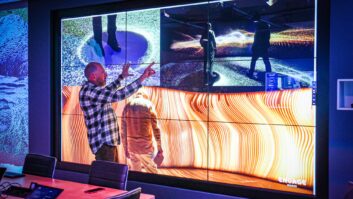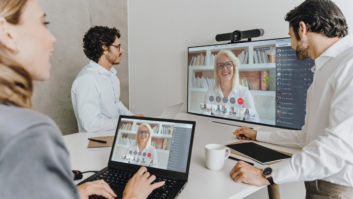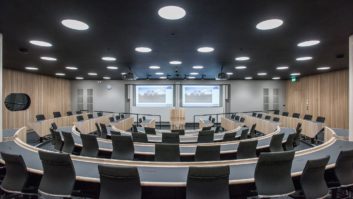 As we step back and do a yearly roundup of what corporate AV looked like in 2021 and how we see it changing in 2022, there have been a few key takeaways. These include the types of meeting spaces being built, the types of technology being deployed, the growing AV managed service (AVSM) market, and the total experience from at-home work to in-office collaboration.
As we step back and do a yearly roundup of what corporate AV looked like in 2021 and how we see it changing in 2022, there have been a few key takeaways. These include the types of meeting spaces being built, the types of technology being deployed, the growing AV managed service (AVSM) market, and the total experience from at-home work to in-office collaboration.
It’s no secret that hybrid work is here to stay, but how are companies evolving to support this new infrastructure? The answer is simple, they are transforming the outdated office layout and building out sophisticated collaborative spaces. These spaces need to be equipped with better video conferencing, lighting, sensors, and superior audio quality so the meeting sounds and looks just as good if you are working from a quiet home office to a large conferencing centre.
Companies are modifying the individual desk areas from pre-pandemic and upgrading them to teamwork areas, dedicated meeting spaces, and large event spaces. Based on research conducted by Gartner, 90% of meetings will have participants joining from a remote location. Because of this, there has also been an approximate 44% increase in the use of collaboration tools compared to 2019.
CONTINUING TRENDS
Pre-pandemic, organisations typically saw an average of 63% of their staff in in-person meetings. In 2021, we were seeing an average just shy of 35% of employees in-person. Gartner predicts that we will keep seeing this trend through 2024 with an average attendance of only 25% of people joining meetings in person. This has been the reason an increasing amount of organizations worldwide are adopting collaborative spaces over the traditional cubical. They already have the real estate, so why not repurpose it.
Real estate isn’t the only thing that’s been getting a face-lift this past year moving into 2022. When we talk about the need for upgrading the physical office space to support the new way of collaboration, we have also started seeing a trend in the market with the types of hardware that are being deployed to these new spaces. The industry as a whole has seen a major shift in the AV/UC devices that are now being produced due to hybrid and remote work. USB-based devices are starting to become increasingly popular. In 2021, 56% of all AV devices shipped have been USB-centric, however, this only accounts for 15% of total revenues in the industry as reported by market research firm Futuresource Consulting. Based on research done by Futuresource, 41% of people today are connecting to video calls using a laptop.
OPEN DOORS
The move away from traditional AV hardware has opened the doors for companies such as Logitech, Poly, Yealink, Bose, BiAmp, Neat, Lenovo etc. to become major players in the videoconferencing space. These solutions are generally lower cost, modern, and semi-portable which makes refreshing the conferencing and collaboration areas that much easier.
Another additional benefit to the new and upcoming USB based devices and cloud-based services is the fact that they are taking security standards and the ability to integrate with management, monitoring, and control products such as the Utelogy Software Platform into consideration. Today’s organisations want to be able to have reliable cost-effective equipment that’s also able to be managed under a single pane of glass for their entire estate. As the workforce, technology solutions, and locations become increasingly diverse, so should the different ways we can make engaging, powerful, and interactive collaboration available. We need agnostic solutions that can be easily monitored and managed.
PROFESSIONAL SERVICES
Because of the way this new technology is transforming the industry and how businesses operate, organisations are finding themselves in need of professional AV managed services (AVSM) with proper day-2 support. One of the challenges we are currently facing is that only 1% of the market is covered. Industry market research firm Futuresource Consulting predicts an increase from $900m to $4.3b in 2024.
With the push to more cloud-based solutions, more portable, and affordable video conferencing devices, and limited staff, there is a major challenge in today’s current market for adequate training and support. There are currently not enough experienced providers to serve the client base, meaning more and more end-users will be left with a variety of AV, UC, and IT solutions that have no interconnectivity with noone who knows how to manage or get insights into an organization’s AV estate. Technology has changed so rapidly in the last couple of years that organizations are having a tough time narrowing the skills gap, and providers of the services don’t have enough employees to train all of their customers.
SHIFTING PRIORITIES
In 2021, we started to see the shift in the way organizations think about not only the physical office spaces and how we use and implement new technology as discussed, but also the people who work there, the people businesses serve, and how all of this combined affects business outcomes. Pre-pandemic the world was heavily focused on customer experience and user experience. As we implement the hybrid working model across the globe and introduce new technologies we have added employee experience and multi experience (voice, touch, and gesture) to this formula, creating what the industry is calling the total experience (TX).
A connected workforce is an instrumental driver for positive business outcomes. There is much growth potential for the AV, UC, IT and AVSM industries. It will be interesting to see how it unfolds throughout the next couple of years and how this new way of working affects the total experience of an organisation.







